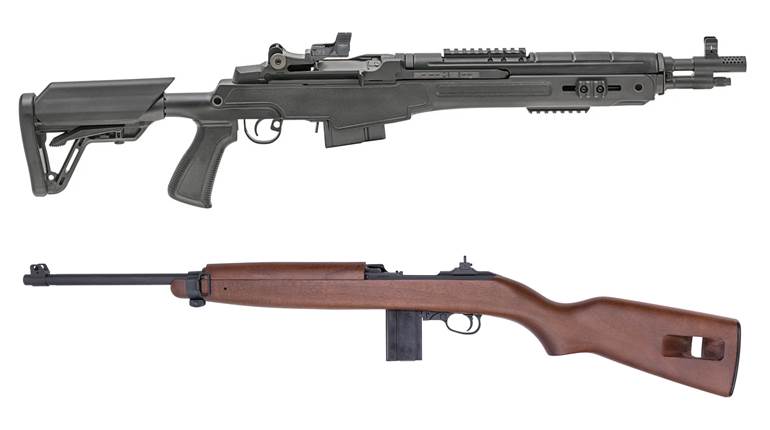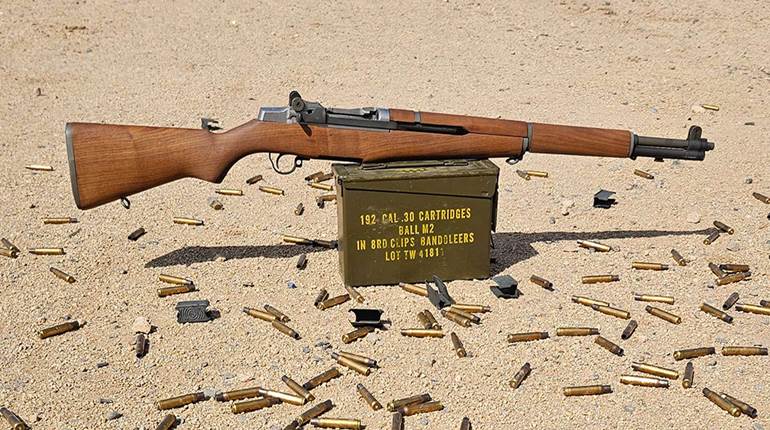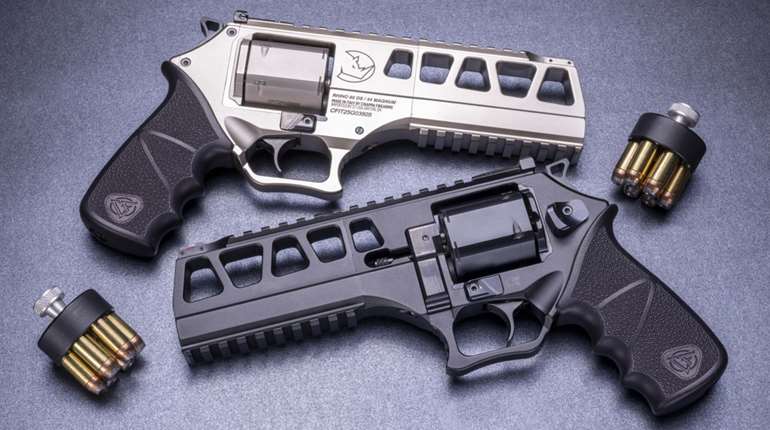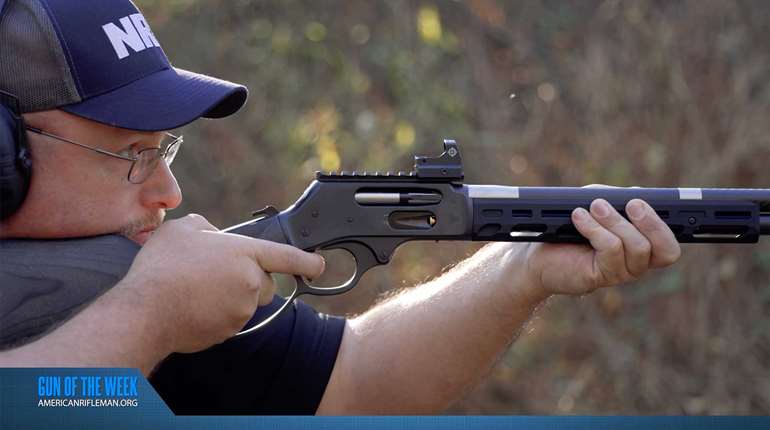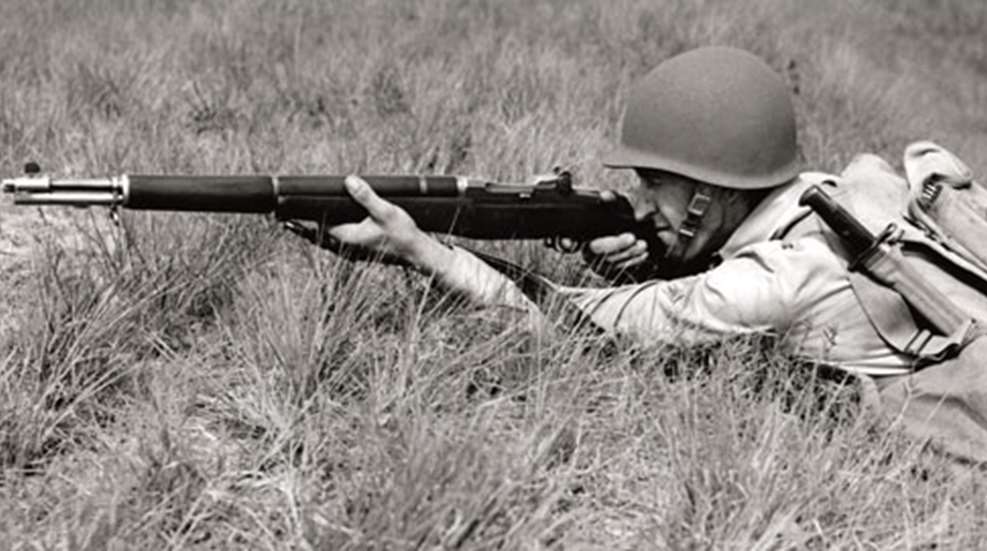
In 1936, the United States was still in the throes of the Great Depression. The woefully misnamed “War to End All Wars” had concluded fewer than 20 years earlier, and its painful memories were still fresh in the minds of many Americans. Isolationist sentiment was prevalent, and there was little enthusiasm for anything military. It would seem a most unlikely time for the U.S. Army to adopt a state-of-the-art semi-automatic service rifle. Nonetheless, 75 years ago that is exactly what happened with the standardization of the “U.S. Rifle Semiautomatic, Caliber .30, M1.” Today, the M1 rifle, often referred to as the “Garand” in deference to its inventor, John C. Garand, is one of the best-known and most iconic military rifles of all time.
Even though the U.S. military had announced a desire to field a semi-automatic service rifle as early as 1900, the technology to develop a satisfactory arm of this type was slow in coming. A great many designs, foreign and domestic, were tested and evaluated during the intervening 30 years, but none were deemed suitable. The M1 rifle did not appear suddenly; it was the culmination of almost 20 years of toil by Garand, Springfield Armory and the U.S. Army Ordnance Dept.
A virtually unknown immigrant from Canada, Garand had begun work on a novel design for a light machine gun in 1918. His efforts came to the attention of the American government, and in 1919 Garand was offered a position at Springfield Armory and tasked with developing a semi-automatic service rifle. Garand’s initial rifle featured a novel primer-actuated mechanism, but this was eventually found to be unsuitable, so he switched to a more conventional gas-operated design.
Springfield also engaged the services of well-known gun designer John Pedersen to work on a semi-automatic rifle in parallel to the development of Garand’s rifle. Pedersen proposed a design that not only differed substantially from Garand’s, but he also touted the virtues of a .276 cartridge to replace the standard .30 Springfield (.30-’06 Sprg.). For a while, it appeared all but certain that the Pedersen and the .276 would be the new U.S. service rifle and cartridge combination. For a variety of reasons, however, including large stocks of .30-cal. ammunition still on hand from World War I, the Garand rifle, chambered for the .30-’06 Sprg. round, was recommended for adoption.
On Jan. 9, 1936, the “U.S. Rifle Semiautomatic Caliber .30 M1” was officially standardized by the U.S. Army. The word “Semiautomatic” was soon dropped from the rifle’s nomenclature and the official designation became “U.S. Rifle, Caliber .30, M1.” As aptly put by Alexander Rose, “For the first time in living memory, the United States was actually ahead of its traditional competitors in rifle development; Britain, France, and Germany all went to war in 1939 with the same rifles they had used in 1914…The Garand couldn’t have come along at a better time.”
With the official adoption of the M1 rifle, the Ordnance Dept. made plans for mass production. The sheer magnitude of the engineering work involved, however, along with the acquisition of the machinery required to manufacture a modern firearm, made for a truly daunting task for Springfield, which had not tooled up to produce a new rifle since 1903. Severe budgetary cuts had resulted in the termination or retirement of many experienced workmen, and much of the production equipment on hand was antiquated. The precarious fiscal conditions in the late 1930s made the task of securing necessary funds very difficult.
Even after the Garand’s adoption, some within Springfield harbored doubts as to whether efficient mass production of the rifle was even possible. This was addressed by Edward C. Ezell in “The Great Rifle Controversy:” “[T]he belief of the industrial personnel at the Armory [was] that the M1 rifle could not be successfully mass-produced. They argued that the breech mechanism was too complicated to be fabricated in large quantities. Had the U.S. Army listened to these Cassandras, the M1 rifle would never have been manufactured. The opinion of the production people at the Armory did not prevail because John Garand knew his rifle could be mass-produced. That had been one of the basic elements of his design exercise. To prove his point he created and fabricated much of the special tooling required to manufacture the M1. Using that production tooling, the Springfield Armory and the Winchester Repeating Arms Company successfully produced more than four million M1s during World War II.”
Colonel James L. Hatcher also made reference to these production critics in a 1939 lecture he presented to students at the Army Industrial College: “Some poorly informed critics of the M1 rifle have pointed out several components as being impossible or very difficult to make. It may be of interest to you to note that the operations on these parts were tooled by Mr. Garand himself, and to the confusion of the critics, in each instance these are the operations being produced at the highest rate and with the least difficulty.”
The first machine-made production M1s were delivered in September 1937 at the initial rate of 10 rifles per day. By March 1, 1938, the daily rate had increased to 20; by July 1939 the rate had gone up to 80; and by Sept. 1, 1939, it was 100 per day. On Jan. 22, 1940, the daily rate of production had reached 200. While these would have been considered ridiculously low just a few years later, at the time they were deemed sufficient to result in arming the small U.S. armed forces with M1 rifles in a reasonable time period. As more M1s became available, a few were shipped to various Army installations for familiarization and limited field use in the Fiscal Year ending June 30, 1937.
Unforeseen production difficulties and the uncertain availability of continued funding resulted in the supply being far short of initial estimates. An interesting exchange of letters between the Cavalry Board and the Ordnance Dept. in early 1937 provides some insight into the military’s plans for production and issuance of the M1. The first letter was from Cavalry Maj. Charles Houghton to Lt. Col. Sidney P. Spalding at the Ordnance Dept.: “First, how many rifles, caliber .30, 1903 and 1917, have we in war reserve and in the hands of troops? Second, what is the present and prospective rate of manufacture of the new M1 semi-automatic rifle? The reason for these two questions is that it appears that some officers here at the Cavalry School are basing their plans and ideas on the probability that a M1 semi-automatic rifle will be in the hands of all Regular Army and National Guard troops within a relatively short time, and that there will be a sufficient war reserve to equip reserve units.”
Colonel Spalding’s reply cited the following estimates and pointedly mentioned the production and funding problems being experienced by Springfield Armory: “The total stock of Caliber .30 Rifles, M1903 is 901,548. Of these 506,514 are in the hands of troops. The total stock of Caliber .30 Rifles, M1917, is 2,174,893 of which only a very small number are in the hands of troops.
“The status of production of the Caliber .30 M1 Rifle (heretofore known as the U.S. Rifle, Semiautomatic, Caliber .30, M1) is as follows: It is estimated that 1,500 rifles will be completed by July 1st. During the fiscal year 1938 it is expected that 6,960 rifles will be manufactured. Of the first 3,370 to be manufactured the Cavalry School is supposed to receive sixty and the First Cavalry Division of Fort Bliss sixty. No funds for the manufacture of this rifle are carried in the estimates of fiscal year 1938. The guns manufactured during that fiscal year are to come from hold-over money.
“We are now struggling with the usual difficulties at Springfield Armory and definite facts are not available as to production possibilities or actual costs. It is difficult to forecast how many rifles will be provided for in future budgets. The gun is yet to have a real test in the hands of troops in large quantity, and until such a test has been made it seems to me we should at least have alternate plans based on material actually on hand.”
Not only was the future of the M1 rifle dependent on continued funding, its success in the hands of troops when issued in meaningful numbers would be evaluated to make sure it performed up to expectations. A January 1938 memo from the chief of ordnance to Springfield Armory’s commanding officer commented on the initial positive reports on the Garand starting to come in from the field, along with a challenge to increase the manufacturing rate: “[I]t is most gratifying to note that the semi-automatic rifle is now in production. Reports being received from the using troops to whom the production rifles have been issued are most enthusiastic as to its performance…The demand from troops to be equipped with this important weapon is very urgent and every effort should be made to fill current orders promptly. Manufacturing methods should be restudied so as to get increased production and to cut costs in every way possible.”
Despite the “most enthusiastic” reception of the rifle by the troops, a number of problems surfaced as its use increased. One was the so-called “Seventh Round Stoppage.” It was eventually discovered that this vexing condition was caused by a small portion of the inside of the receiver being inadvertently sheared during production. A slight recalibration of the tooling eliminated the problem. It was also discovered that the M1 rifle’s action could “freeze” when exposed to excessive amounts of water, such as a driving rain. It was determined that a graphite-based grease applied to the camming areas would help alleviate the problem.
The most significant shortcoming of the original M1 rifle proved to be the design of the gas system. The original mechanism trapped some of the gas in an open space between the muzzle and a cap over the muzzle, forcing it back through a cylinder to operate the action. These early M1s have unofficially been dubbed “gas trap” rifles in recognition of its gas system. As these rifles entered service, several deficiencies of the original gas system became apparent, including a propensity for the gas cylinder to become loose, difficulty in cleaning and insufficient strength for attachment of a bayonet. To address the issue, John Garand and the Springfield Armory Engineering Dept. designed a new gas system. First tested in early 1939, it featured a gas port drilled into the barrel to channel the escaping gas that impinged on the operating rod’s piston to force it backward to operate the action. The revised design required a 24-inch barrel as compared to the original (gas trap) M1 rifle’s 22-inch barrel. Springfield Armory began production of these new “gas port” rifles in June 1940. With this change, the basic mechanism of the M1 rifle remained unchanged for the next 16 years.
The American Rifleman was one of the first publications to profile the M1 rifle in any appreciable detail in an August 1938 article written by Ordnance Maj. G.H. Drewry entitled “Our New Service Rifle.” The piece contained little more than a cursory recitation of the events leading up to the adoption of the M1 rifle and a brief synopsis of the current state of production.
Initially, most of the media coverage of the Garand was slightly favorable to somewhat neutral, but it didn’t take long for the rifle to receive an inordinate amount of scrutiny and criticism. One such example was a letter submitted by an NRA member and printed in the October 1940 The American Rifleman. The letter contained a number of detailed complaints and cited numerous perceived deficiencies of the M1.
“Garand Critique—Hope you can wade through this, and that it may secure some result—Lord knows something MUST be done. I spent an afternoon on the range with some choice copies of Mr. Garand’s great mistake recently. And with some 25 years’ experience with military firearms, two years as a sniper and some combat experience, plus a great deal of observation and training as an enlisted man and officer, it is my prophecy that unless this rifle is altered in [some] very important respects, that any unit armed with it will be defeated if faced by any trained and determined foe that has ordinary bolt-action rifles, either in offensive or defensive operations … .
“I have been writing, and encouraging others to write, to their Congressmen and Senators to require the Infantry Board to make a real miss-and-out test of this rifle, against the other available types of semiautomatics, or to recommend the manufacture of the Model 1917 which is, at the present time, our best war rifle. (Absolutely fool proof and reliable!! I threw away a scope-sighted Springfield as a sniper, for [the M1917’s] superior reliability for all military purposes. Please do not give up the fight for a reliable autoloading rifle (or the Model 1917!!). Arthur Shivell, Los Angeles, Calif.”Such opinions were by no means uncommon during this period, and the Garand rifle was being routinely and relentlessly pilloried in the press, including a number of pointedly unfavorable articles in The American Rifleman.
But not every NRA member agreed with the NRA’s treatment of the M1 rifle during this period. Respected firearm writer Capt. Charles Askins, Jr., Guns and Ammunition Editor for “Outdoors” magazine, felt so strongly about the inappropriateness of the NRA’s stance that he fired off the following letter, dated June 6, 1940, to NRA headquarters in Washington, D.C.:
“Immediately upon receipt of this letter you will cancel my life membership in the National Rifle Association. I want you to know that I very heartily disapprove of the campaign of criticism being carried on by the National Rifle Association toward our Service arm the Garand rifle. In times like these the editorials published by the National Rifle Association aimed at discrediting this arm and reflecting on the people instrumental in adopting it, are, to say the least, ill-advised and untimely. When certain NRA officials in high places within the organization set themselves up as virtual one-man ordnance testing boards and without the authority of the Ordnance Dept. and without the invitation of it find fault with our military rifle, I for one have no desire to condone such action by continuing membership in the Nat’l Rifle Association.”
Another challenge to the M1 rifle was the development of a competing semi-automatic rifle in the late 1930s by Melvin M. Johnson, Jr., a Boston attorney with an interest in, and talent for, firearm design. Johnson was a fervent detractor of the Garand and, unsurprisingly, felt his recoil-operated rifle was far superior. After several preliminary tests, the Ordnance Dept. turned its nose up and its thumbs down at the Johnson rifle and remained firmly committed to the Garand. Not easily dissuaded, Johnson, literally, made a “federal case” out of the situation by persuading friendly U.S. congressmen and senators that the nation was making a huge mistake by adopting a rifle as badly flawed as the M1. This resulted in several high-profile and well-publicized House and Senate hearings in 1940 that, ultimately, resulted in the M1 remaining the standardized U.S. service rifle.
Despite the doubts, criticisms and invectives hurled at the M1 rifle from circa 1938 to 1940, the Garand’s subsequent success on battlefields around the globe in World War II and Korea silenced the critics and made many of them look foolish. The trials and tribulations experienced with the early Garand rifles are often unknown or overlooked today. Indeed, some may be surprised that such a famed and venerated rifle was not universally welcomed with open arms when it first came on the scene in 1936. What a difference 75 years makes!













